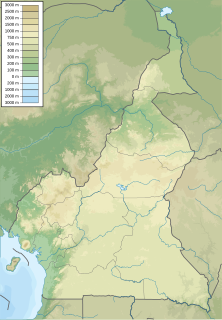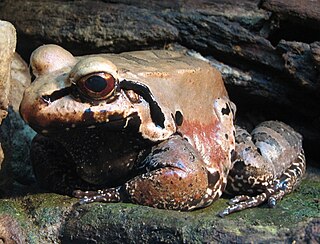Dryaderces pearsoni is a species of frog in the family Hylidae. Broadly defined, it is found in Bolivia, Brazil, and Peru. However, the nominal taxon includes two species, and true Dryaderces pearsoni is only known with certainty from Bolivia. The specific name pearsoni honors Nathan E. Pearson, an American ichthyologist who made a "splendid collection of amphibians" during an expedition to Bolivia, including the holotype of this species. Common name Pearson's slender-legged treefrog has been coined for the species.

Plectrohyla guatemalensis, also known as the Guatemala spikethumb frog, is a species of frog in the family Hylidae. It occurs in the highlands of the Sierra Madre from southeastern Chiapas, Mexico, and eastward through the central and southwestern highlands of Guatemala to northwestern El Salvador as well as the Sierra de Nombre de Dios in north-central Honduras. It might be a composite of more than one species.

Alexteroon jynx is a species of frog in the family Hyperoliidae. It is endemic to the Rumpi Hills in southwestern Cameroon. The common name smooth egg-guarding frog has been proposed for this species.
Yunganastes ashkapara is a species of frogs in the family Craugastoridae. It is endemic to Bolivia and is known from the vicinity of its type locality in the Chapare Province and from Abra de la Cruz in the Manuel María Caballero Province. The specific name ashkapara is derived from Quechuan ashka meaning "a lot" and para for "rain", and refers to the very high rainfall in the region of the type locality.
Gastrotheca andaquiensis, commonly known as the Andes marsupial frog, is a species of frog in the family Hemiphractidae. It is found on the Amazonian slopes of Andes in southern Colombia and Ecuador.

Gastrotheca excubitor is a species of frog in the family Hemiphractidae. It is endemic to southern Peru and occurs in the Amazonian slopes and crests of the Cordillera Oriental in the Cusco Region; records from the Cajamarca Region are likely erroneous. It is likely to include cryptic species. Common name Abra Acanacu marsupial frog has been coined for it.
Gastrotheca ochoai is a species of frog in the family Hemiphractidae. It is endemic to southern Peru and occurs in the interandean valleys on the eastern face of the Andes. The specific name ochoai honors Oscar Ochoa Mendieta, a biology professor from the National University of Saint Anthony the Abbot in Cuzco who helped the species descriptors during the field work. Common name Chilca marsupial frog has been coined for this species.

Gastrotheca splendens is a species of frog in the family Hemiphractidae. It is endemic to Bolivia. The only precisely known record is from the eastern slopes of the Andes in the Amboró National Park, in the Santa Cruz Department. Only two specimens are known. Common name Schmidt's marsupial frog has been coined for this species, in reference to Eduard Oscar Schmidt who described the species.
Oreobates choristolemma is a frog species in the family Craugastoridae. It is endemic to Bolivia where it is known from its type locality, Serranía de Bella Vista in the Caranavi Province as well as from Sud Yungas Province and from Chapare Province in the Cochabamba Department.
Oreobates saxatilis is a species of frog in the family Craugastoridae. It is endemic to Peru and known from near its type locality near Tarapoto as well as from the Río Tambo District in the Satipo Province, Panguana in the Puerto Inca Province, and Río Kimbiri in the La Convención Province. Common name Tarapoto big-headed frog has been coined for it.
Lynchius simmonsi is a frog species in the family Craugastoridae. It is endemic to southern Ecuador where it is known from the type locality in the Cordillera del Cóndor, Morona-Santiago Province as well as from the adjacent Zamora-Chinchipe Province. Its natural habitat is subtropical old-growth forest. The type series was collected by day on the forest floor. The area was mined during the Cenepa War in 1995, and has consequently seen little human activity, although this may change through a proposed road.

The smoky jungle frog is a species of frog in the family Leptodactylidae. It is found in Bolivia, Brazil, Colombia, Ecuador, Costa Rica, Panama, French Guiana, and Peru. Its natural habitats are tropical and subtropical moist broadleaf forests, subtropical or tropical swamps, subtropical or tropical moist montane forest, rivers, freshwater marshes, intermittent freshwater marshes, and aquaculture ponds.
Psychrophrynella bagrecito is a species of frog in the family Craugastoridae. It is endemic to the Cusco Region, Peru, and found on the Amazonian slopes of the Andes at elevations of 1,830–2,740 m (6,000–8,990 ft) asl. The specific name bagrecito is Spanish meaning a small catfish, and a nickname for David Cannatella, a colleague of John D. Lynch, the scientist who described the species from specimens collected from near Marcapata.

Lynchius flavomaculatus is a species of frog in the family Craugastoridae. It is found in the Andes of southern Ecuador and northern Peru.
Oreobates pereger is a species of frog in the family Craugastoridae. It is endemic to Peru where it is known from the eastern slopes of the Cordillera Oriental and Cordillera Vilcabamba mountain ranges.
Noblella myrmecoides is a species of frog in the family Craugastoridae. It is found in the upper Amazon Basin of southeastern Colombia, eastern Ecuador, eastern Peru, Bolivia, and western Brazil (Amazonas). Common name Loreto leaf frog has been coined for this species.
Pseudophilautus singu is a species of frog in the family Rhacophoridae, endemic to southwestern Sri Lanka. It is known from the Kanneliya-Dediyagala-Nakiyadeniya, Kitulgala, and Kottawa Forest Reserves and from the Sinharaja World Heritage Site. The specific name singu is Sinhalese for "horn" and refers to the horn-like tubercles on the upper eyelids of this frog. Common name Sri Lanka short-horned shrub frog has been coined for it.

Psychrophrynella is a genus of frogs in the family Craugastoridae. Alternatively, it has been placed in the family Strabomantidae. The genus is distributed on the Andes of southern Peru and Bolivia. One of the four species assessed by the International Union for Conservation of Nature (IUCN) is assessed as "Critically Endangered".

Psychrophrynella usurpator is a species of frogs in the family Craugastoridae. It is endemic to Peru and known from near Abra Acjanacu, a mountain pass in the Cordillera de Paucartambo, the easternmost Andean range towards the Amazonian lowlands, and from the high elevation grasslands of the Manu National Park. It is named usurpator because these frogs were previously misidentified as Noblella peruviana—in a sense, they had "usurped" the name of another frog species.

Psychrophrynella chirihampatu is a species of frogs in the family Craugastoridae. It is endemic to Peru and only known from its type locality, Japumato Valley in the Peruvian Andes in the Cusco. Common names Japumayo Andes frog has been coined for this species.








